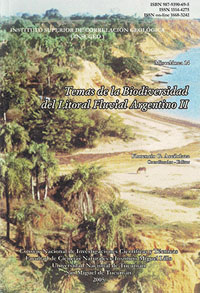Miscelánea 14
Algunas Ardeidas del valle de inundación del Río Paraná: Consideraciones sobre el nicho ecológico y mecanismos de aislamiento
Adolfo H. Beltzer | Martín A. Quiroga | Juan A. Schnack
Descargar trabajo en formato PDFAbstract
CONSIDERATIONS ON ECOLOGIC NICHE AND ISOLATING MECHANISMS OF SOME ARDEIDAE SPECIES IN THE ALLUVIAL VALLEY OF PARANA RIVER. Herons are one of the best represented families in the flood plain of the Paraná River (10 species). That the interspecific competition constitutes the most significant factor in resources distribution is a prevailing idea in the ecological theory. According to recent studies, it has been shown that even though competition is important, the modelling of the communities structure results from the combined action of other factors which sporate independently of the interspecific interaction. The distribution of resources is closely related to the ecological niche concept, this being the quantitative description of the organic unity requirements. It is hypothesized in our work that the four studies species: Casmerodius albus (Great Egret), Egretta thula (Snowy Egret), Butorides striatus (Striated Heron) and Nycticorax nycticorax (Black-crowned Night Heron), their sympatry being observed, have developed adaptative mechanisms of ecological segregation. This let them use the resources in such a way that their diet composition (trophic subniche) and other parameters of their ecological requirements (temporal and spatial subniche) are differentiated. The index of relative importance IRI (Pinkas, et al., 1971) was applied to calculate the contribution of each food category to each species diet. The trophic overlapping of the alimentary spectra was determined by using the percentage of similarity according to Colwel and Futuyma (1971). The accumulated trophic diversity was calculated following the Hurtubia criterion (1978), the minimum sample for each species being then obtained. The feeding efficiency was measures by means of Acosta Cruz equation (1988) and to evaluate the feeding selectivity. Spearmans range correlation (rs) was employed. The trophic spread of the niche was estimated through Levins equation (1968). The spatial subniche evaluation was achieved with the index of habitat preference (Pi) according to Duncan (1983), whereas the mean index of fullness by Maule and Horton (1984) was applied to determine temporary dimension evaluation. As regards trophic spectrum even though fishes were found to be the basic diet for al four species and insects the second food category, slight differences exist between them which would establish mechanisms at the catches level. This is reinforced by the low overlapping values obtained and the lack of significance in the selectivity values. Variations concerning temporal and spatial subniches were also obtained. Summarizing, the coexistence in mainly based on the differential utilization of the resources as basic isolation mechanisms and lezz subtly on space and time. Without leaving aside the usefulness of further research, we think these results provide valuable data for the understanding of the Paraná complex system dynamics.






